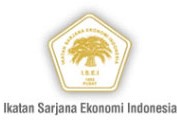Dynamic Forecasting of Government Foreign Debt: Case of Indonesia
(1) Universitas Negeri Semarang
(2) Universitas Negeri Semarang
Abstract
Keywords
Full Text:
PDFReferences
Al-Shiab, M. (2006). The Predictability of Amman Stock Exchange Performance: A Univariate Autoregressive Integrated Moving Average (ARIMA) Model. European Journal of Economics, Finance and Administrative Sciences, 22(6), 124–39.
Apergis, E. & Apergis, N. (2019). New Evidence on Corruption and Government Debt from a Global Country Panel: A Non-Linear Panel Long-Run Approach. Journal of Economic Studies, 46(5).
Balli, F., & Elsayed, M. E. (2012). Modelling the Currency in Circulation for the State of Qatar.†International Journal of Islamic and Middle Eastern Finance and Management 5 (4), 321–39.
Bank of Indonesia. (2020). External Debt Statistics of Indonesia, XI Februari 2020.
Bui, D-T., (2019). Fiscal Sustainability in Developing Asia – New Evidence from Panel Correlated Common Effect Model. Journal of Asian Business and Economic Studies, 27(1), 66–80.
Charles, C., & Shon, J. (2018). The Impact of Public Debt on State Borrowing Cost in the US Bond Market before the Great Recession. Journal of Public Budgeting, Accounting and Financial Management, 30(3), 335–46.
Chatterjee, B., Bhattacharya, S., Taylor, G., & West, B. (2019). Political Competition and Debt: Evidence from New Zealand Local Governments. Accounting Research Journal, 32(3), 344–61.
Choi, S-W., & Luo, S. (2019). The Politics of the Executive, Legislative Veto Players and Foreign Debt. International Trade, Politics and Development, 3(2), 82–99.
Cholifihani, M. (2008). A Cointegration Analysis of Public Debt Service and GDP in Indonesia. Journal of Management and Social Sciences, 4(2), 68–81.
Culpeper, R. & Kappagoda, N. (2016). The New Face of Developing Country Debt. Third World Quarterly, 37(6), 951–74.
Dinca, Gheorghita, & Marius, S. D. (2015). Public Debt and Economic Growth in the EU Post-Communist Countries. Romanian Journal of Economic Forecasting, 18(2), 119–32.
DiPeitro, W.R., & Anoruo, E. (2012). Government Size, Public Debt and Real Economic Growth: A Panel Analysis. Journal of Economic Studies, 39(4), 410–19.
GarcÃa, D. A. (2008). Government Debts and Financial Markets in Castile Between The Fifteenth and Sixtheeth Centuries. In Government Debts and Financial Markets in Europe, edited by Fausto Piola Caselli. London: Pickering & Chatto.
Iskandar, I., Willett, R., & Xu, S. (2018). The Development of a Government Cash Forecasting Model. Journal of Public Budgeting, Accounting and Financial Management, 30(4), 368–83.
Jadevicius, A., & Huston, S., (2015). ARIMA Modelling of Lithuanian House Price Index. International Journal of Housing Markets and Analysis, 8(1), 135–47.
Jilenga, M.T., Xu, H., & Gondje-Dacka, I-M. (2016). The Impact of External Debt and Foreign Direct Investment on Economic Growth: Empirical Evidence from Tanzania. International Journal of Financial Research, 7(2), 154–62.
Luca, G. D. (2008). Government Debt and Financial Markets: Exploring Pro-Cycle Effects In Northern Italy During The Sixteenth and The Seventeenth Centuries. In Government Debts and Financial Markets in Europe, edited by Fausto Piola Caselli. Pickering & Chatto.
Martinez, A. B. (2015). How Good Are US Government Forecasts of the Federal Debt?. International Journal of Forecasting, 31(2), 312–24.
Mhlaba, N., & Phiri, A. (2019). Is Public Debt Harmful towards Economic Growth? New Evidence from South Africa. Cogent Economics and Finance, 7(1), 1-15
Mosikari, T. J., & Eita, J. H. (2017). Empirical Test of the Ricardian Equivalence in the Kingdom of Lesotho. Cogent Economics and Finance, 5(1), 1-11
Ncanywa, T., & Masoga, M. M. (2018). Can Public Debt Stimulate Public Investment and Economic Growth in South Africa?. Cogent Economics and Finance, 6(1), 1–13.
Odom, J. (2018). Public Debt and the Common Good. Public Debt and the Common Good. New York: Routledge.
Ramzan, M., & Ahmad, E. (2014). External Debt Growth Nexus: Role of Macroeconomic Polices. Economic Modelling, 38, 204–10.
Stevenson, S. (2007). A Comparison of the Forecasting Ability of ARIMA Models. Journal of Property Investment & Finance, 25(3), 223–40.
Strizzi, N., & Kindra, G. S. (1998). Foreign Debt in Asia Pacific and the Latin American and Caribbean Region: Is There a Cause for Concern?. European Business Review, 98(4), 235–44.
Žaja, M. M., Kržić, A. S., & Habek, D. (2018). Forecasting Fiscal Variables in Selected European Economies Using Least Absolute Deviation Method. International Journal of Engineering Business Management, 10, 1–19.
Refbacks
- There are currently no refbacks.

This work is licensed under a Creative Commons Attribution 4.0 International License.






